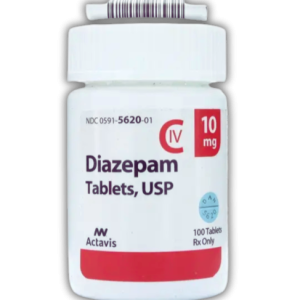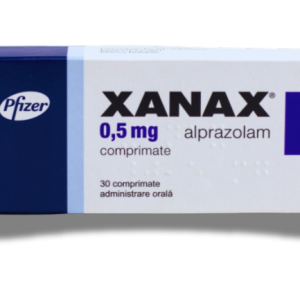Description
Lorazepam is one of the most widely prescribed benzodiazepines in clinical practice. It plays a key role in managing anxiety, seizures, and acute agitation.
This medication works by boosting the calming chemical GABA in the brain. Patients dealing with severe anxiety, panic attacks, or dangerous seizures often get rapid relief from lorazepam.
Despite decades of use in hospitals and clinics, many patients and even some healthcare professionals don’t fully understand its complex pharmacology or best uses.
Lorazepam stands out from other benzodiazepines because of its unique metabolism and fast onset. It doesn’t form active metabolites and shows predictable effects across different patients.
These traits make it especially valuable in emergencies when quick, reliable sedation is needed.
Pharmacological Profile of Lorazepam
Lorazepam’s pharmacological profile is shaped by its benzodiazepine structure and 3-hydroxy configuration. It acts on GABA-A receptors and has favorable pharmacokinetics, including direct glucuronidation and minimal dependence on liver enzymes.
Chemical Structure and Properties
Lorazepam belongs to the 1,4-benzodiazepine class and features a 3-hydroxy configuration. This sets it apart from drugs like diazepam.
The 3-hydroxy group gives lorazepam unique pharmacokinetic benefits. It doesn’t create active metabolites during breakdown.
This structure lets lorazepam undergo direct conjugation without needing cytochrome P450 enzymes. The drug stays stable and keeps its effects consistent.
Its molecular setup allows for quick absorption and effective crossing of the blood-brain barrier. After a 2 mg oral dose, peak plasma concentrations hit about 20 ng/mL.
Pharmacodynamics
Lorazepam attaches to benzodiazepine receptors on postsynaptic GABA-A chloride channels throughout the central nervous system. This binding happens at several spots in neural tissue.
The drug boosts GABA’s inhibitory effects by increasing chloride ion flow. This causes cell membranes to hyperpolarize and stabilize.
Six main therapeutic effects come from this mechanism:
- Anxiety reduction (anxiolysis)
- Anterograde amnesia
- Sedation and hypnosis
- Anticonvulsant effects
- Antiemetic properties
- Muscle relaxation
The action in the amygdala helps with anxiety disorders. Cortical inhibition is key for managing seizures.
Lorazepam acts fast when given intravenously, usually within 1-3 minutes. Intramuscular injections take 15-30 minutes to kick in.
Pharmacokinetics
Lorazepam has excellent oral bioavailability, around 90% after administration. Peak blood levels appear about two hours after an oral dose.
The drug spreads widely, with a volume of distribution of 1.3 L/kg. About 90% binds to plasma proteins, and it crosses the blood-brain barrier by passive diffusion.
Metabolism mainly happens through hepatic conjugation, forming lorazepam glucuronide, which is inactive. Since it doesn’t rely on cytochrome P450, it’s a good choice for patients with liver issues.
| Parameter | Value |
|---|---|
| Half-life | 14±5 hours |
| Clearance | 1.1±0.4 mL/min/kg |
| Bioavailability | ~90% |
| Peak concentration | 2 hours (oral) |
The drug goes through enterohepatic recirculation before final elimination. Most of it leaves the body in urine, and kidney problems don’t really change how it’s processed.
Mechanism of Action
Lorazepam works by binding to certain receptors in the central nervous system. It enhances the brain’s natural inhibitory processes, leading to sedation, anxiety relief, and anticonvulsant effects through targeted changes in neuronal activity.
GABAergic Modulation
Lorazepam connects with benzodiazepine receptors on postsynaptic GABA-A chloride channels. These receptors are spread throughout the CNS.
The drug ramps up the inhibitory effects of GABA, the brain’s main calming neurotransmitter. When lorazepam binds, it increases the flow of chloride ions into the neuron.
This extra chloride causes the cell membrane to hyperpolarize. The neuron becomes less likely to fire.
Lorazepam doesn’t change how GABA is made or released. Instead, it amplifies GABA’s usual effects when the neurotransmitter hits its receptor.
Central Nervous System Effects
The drug’s action in the amygdala brings its anti-anxiety benefits. This area of the brain handles fear and anxiety.
Its inhibitory effects in the cerebral cortex help prevent seizures by stopping abnormal electrical activity.
Lorazepam crosses the blood-brain barrier quickly using passive diffusion. After IV administration, effects start in 1-3 minutes.
The drug’s effects on the limbic system and ascending reticular formation play a role in sedation. These areas manage arousal and consciousness.
Lorazepam skips cytochrome P450 metabolism and goes straight to glucuronidation. That’s a big plus for patients with liver dysfunction.
Therapeutic Applications
Lorazepam proves effective in a range of conditions, from anxiety to emergency seizure control. Its fast onset and reliable pharmacokinetics make it especially useful in acute care and surgical settings.
Management of Anxiety Disorders
Lorazepam is often a first-line treatment for anxiety-related issues. The FDA has approved it for short-term relief of anxiety symptoms.
Standard dosing starts at 2-3 mg by mouth, given two or three times a day. Providers should keep daily doses under 10 mg to avoid side effects.
The drug works well for:
- Generalized anxiety disorder (acute phases)
- Panic disorder (off-label)
- Anxiety-related insomnia, with 0.5-2 mg at bedtime
Older adults need lower doses. For those 65 and up, 0.5-1 mg for sleep is usually enough.
Treatment should stay under four months. Longer use raises the risk of dependence and makes the drug less effective as tolerance builds.
Use in Sedation and Preoperative Care
Lorazepam’s calming and amnestic effects make it helpful for preoperative sedation. Patients feel less anxious and often don’t remember uncomfortable procedures.
For intramuscular use, the typical dose is 0.05 mg/kg about two hours before surgery, with a 4 mg max. This route is handy when IV access is tough.
IV dosing is 0.044 mg/kg, given 15-20 minutes before a procedure. Maximum doses are 4 mg for those under 50, and 2 mg for older patients.
Effects start within 1-3 minutes IV, or 15-30 minutes IM. This predictability helps with planning procedures.
The drug causes little cardiovascular depression, which is safer for people with heart issues who need conscious sedation.
Treatment of Status Epilepticus
Status epilepticus is a medical emergency. The American Epilepsy Society lists IV lorazepam as a first-line treatment.
In emergencies, the dose is 0.1 mg/kg IV, up to a 4 mg max. Providers dilute it 1:1 with saline and infuse no faster than 2 mg per minute.
If seizures keep going, you can repeat the dose every 5-10 minutes. Lorazepam’s rapid brain penetration stops seizures within minutes.
Compared to diazepam, lorazepam lasts longer, so seizures are less likely to come back.
For kids, dosing is weight-based and follows similar protocols. Guidelines support its use in pediatric convulsive status epilepticus.
Role in Agitation Control
Acute agitation in hospitals calls for quick, safe sedation. Lorazepam is effective for agitated patients in ERs and ICUs.
ICU protocols use IV loading doses of 0.02-0.04 mg/kg, with a 2 mg single-dose max. Maintenance doses range from 0.02-0.06 mg/kg every 2-6 hours as needed.
In alcohol withdrawal, lorazepam is especially useful. Doses of 1-4 mg IV every 5-15 minutes help calm patients quickly.
Because it doesn’t form active metabolites, lorazepam is safer for those with liver problems—an important point in alcohol-related liver disease.
Sometimes, combining lorazepam with antipsychotics like haloperidol boosts effectiveness. The American College of Emergency Physicians recommends this combo for severe agitation.
Safety and Adverse Effects
Lorazepam comes with important safety considerations, including common neurological effects and serious risks related to dependence. Careful monitoring is needed due to the potential for tolerance and withdrawal problems.
Common Side Effects
The most common side effects hit the central nervous system. Sedation, dizziness, weakness, and unsteadiness show up in more than 1 in 100 people taking lorazepam.
Patients often report daytime drowsiness and disorientation. These can really affect someone’s ability to drive or use machinery safely.
Research breaks down adverse events into several groups. The most common are:
- Psychiatric: Drug abuse, suicide attempts, psychotic episodes
- Neurological: Delirium, stupor
- Physical: Balance issues, cognitive problems
Some studies hint that lorazepam might also mess with fat metabolism or harm the heart, but the evidence isn’t strong yet.
There have been reports of immune-related disorders, but more research is needed to know if there’s a real link.
Lorazepam affects different body systems, and women seem to report side effects more often—about 60% of documented cases come from women.
Risks of Dependence and Withdrawal
Lorazepam comes with real risks for abuse, misuse, and addiction. In severe cases, this can even lead to overdose or death.
When people take lorazepam regularly, physical dependence sets in. The body gets used to the medication, and suddenly stopping can make it tough to feel normal.
If you quit lorazepam cold turkey, serious and even life-threatening withdrawal symptoms can hit. That’s why doctors insist on medical supervision during discontinuation—it’s just safer.
Withdrawal can look different for everyone. Some folks might deal with:
- Severe anxiety and panic attacks
- Seizures, especially in extreme cases
- Tremors and sweating
- Sleep problems and agitation
Doctors usually recommend gradual tapering to lower withdrawal risks. They’ll cut doses slowly, sometimes over weeks or months.
The longer you take lorazepam—or the higher your dose—the more likely you’ll face dependence. People on lorazepam for a long haul often have a tougher time coming off it.
Potential for Tolerance
Tolerance means you need higher and higher doses to get the same effect. With benzodiazepines like lorazepam, this can happen pretty fast.
There’s also cross-tolerance with other benzodiazepines. If you build up tolerance to lorazepam, you’ll probably notice similar meds don’t work as well either.
How quickly tolerance develops really depends on the person. Some notice lorazepam stops working as well after just a few weeks.
Tolerance especially hits the sedative and anxiolytic effects. Suddenly, anxiety creeps back in—even though you’re still taking the medication.
People often feel tempted to up their dose when tolerance sets in. But raising the dose just boosts dependence and side effects, and doesn’t always help much.
Doctors keep a close eye out for signs of tolerance. Regular check-ins help decide if it’s time to try something different.
Clinical Research and Future Perspectives
Researchers are still working to expand lorazepam’s uses, but they’re also tackling safety concerns with careful clinical trials. There’s a real push to find targeted approaches for specific groups, not just the standard anxiety crowd.
Current Research Trends
Pharmacovigilance studies are digging into lorazepam’s side effects using real-world data. These studies look at long-term effects in chronic users and try to spot what puts people at risk for serious problems.
Catatonia treatment research is buzzing right now. Scientists are testing dosing protocols and how long to treat catatonic patients. Some studies show lorazepam can work fast—sometimes in just 10 minutes to a couple hours.
Clinical trials compare lorazepam with meds like diazepam, zolpidem, and clozapine. There’s still a need for more randomized controlled trials to really nail down the best treatment guidelines.
Age-related studies are happening too, especially in older adults. Researchers are looking at dose ranges from 0.5 to 4 mg, and checking for links between lorazepam and things like falls, fractures, hospital stays, and even mortality in seniors.
Innovative Therapeutic Approaches
Scientists are using neuroimaging to figure out how lorazepam works in the brain. PET scans, for example, can show which regions light up after treatment.
GABA receptor research is also heating up. There’s interest in the role of GABAB receptors in catatonia, and maybe this will lead to more targeted treatments down the line.
Some studies look at microstructural white matter as a biomarker for symptom severity and therapy outcomes. If this pans out, it could help doctors predict who’ll respond best to lorazepam.
Combination therapies are getting attention too. Researchers are trying to find protocols that support long-term recovery, not just quick symptom relief.
Frequently Asked Questions
Lorazepam stands out from other benzodiazepines in a few ways. Knowing about its interactions, long-term effects, and best uses can make a real difference for patient safety and treatment success.
What is the pharmacological profile of Lorazepam?
Lorazepam binds to benzodiazepine receptors on GABA-A chloride channels in the central nervous system. This boosts GABA’s inhibitory effects, increasing chloride flow and causing hyperpolarization of nerve cells.
After you take it by mouth, lorazepam hits peak plasma levels in about two hours. It’s got roughly 90% bioavailability and crosses the blood-brain barrier easily by passive diffusion.
The liver processes lorazepam through direct glucuronidation, not the cytochrome P450 pathway. That means it doesn’t create active metabolites—unlike some other benzodiazepines such as diazepam.
On average, the half-life is about 14±5 hours, with a clearance rate of 1.1±0.4 mL/min/kg. Around 90% of lorazepam binds to plasma proteins, and most of it leaves the body through urine.
When given intravenously, lorazepam kicks in fast—usually in 1-3 minutes. Oral forms start working within 20-30 minutes, with full sedative effects showing up after about an hour to an hour and a half.
How does Lorazepam interact with other medications?
Lorazepam mostly interacts with other central nervous system depressants. Mixing it with alcohol, opioids, or barbiturates can be dangerous, raising the risk of respiratory depression and heavy sedation.
Antihistamines and muscle relaxants can make lorazepam’s sedative effects even stronger. People should be careful with these combos—cognitive and motor problems can get worse.
Since lorazepam skips the cytochrome P450 system, it has fewer drug interactions than some other benzodiazepines. That can make it a good pick for patients juggling lots of meds.
Still, certain antifungals and antibiotics can affect lorazepam’s metabolism. Doctors need to check all your meds before prescribing it to avoid surprises.
What are the long-term effects of Lorazepam use on mental health?
Using lorazepam for a long time can bring on dependence and tolerance. People often need higher doses to get the same relief as time goes on.
Cognitive effects can show up too—like memory issues and trouble concentrating. These problems usually get worse with longer use or higher doses.
Withdrawal is a real risk when stopping long-term lorazepam. Symptoms might include rebound anxiety, insomnia, tremors, and, in bad cases, seizures.
Long-term use can also mess with natural coping skills for anxiety. Some people end up relying on the medication instead of building other ways to manage stress.
In what clinical situations is Lorazepam considered the preferred treatment?
Lorazepam is first choice for status epilepticus when given intravenously. Its fast action and reliable absorption make it a go-to in seizure emergencies.
Doctors often pick lorazepam for patients with liver problems. Since the drug is processed by direct glucuronidation, liver dysfunction doesn’t affect it as much as other benzodiazepines.
For alcohol withdrawal, lorazepam is a common option, especially in people with cirrhosis. It manages withdrawal symptoms well and is safer for the liver.
In the ICU, lorazepam is often used for agitation. Its predictable effects and lack of active metabolites are helpful for critically ill patients.
It’s also a solid pick for pre-anaesthetic sedation. Lorazepam reliably eases anxiety and causes amnesia, all without the hassle of active metabolites.
How does Lorazepam’s efficacy compare with other anxiolytics?
Lorazepam works about as well for anxiety as other benzodiazepines like diazepam or alprazolam. Its direct metabolism gives it more predictable effects, though.
Compared to SSRIs, lorazepam brings fast relief. SSRIs can take weeks to kick in, but lorazepam works within hours.
For sudden anxiety or panic, lorazepam often outperforms meds like buspirone or hydroxyzine. Its quick onset makes it especially useful for panic attacks or acute stress.
In older adults, lorazepam might be a better choice than longer-acting benzodiazepines. Its intermediate half-life means less build-up and fewer risks, but it still gets the job done.
What are the guidelines for safely discontinuing Lorazepam therapy?
It’s crucial to reduce the dose gradually to avoid withdrawal symptoms. If someone stops suddenly, especially after high doses or long-term use, seizures can happen.
Most tapering schedules drop the daily dose by about 10-25% per week. Sometimes, people on higher doses or who’ve taken Lorazepam for a long time need to go even slower.
During this process, patients should get regular check-ins. Withdrawal can show up as anxiety, trouble sleeping, or just feeling off physically.
Before stopping, it’s a good idea to have other ways to manage anxiety lined up. Cognitive behavioral therapy, relaxation exercises, and even simple lifestyle tweaks can really help.
Doctors need to keep an eye on things while someone tapers off. They might need to adjust the plan depending on how the person feels or if symptoms get rough.





Reviews
There are no reviews yet.